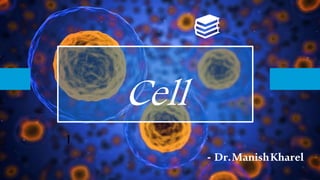
Structure of a human cell
- 2. What is Cell (Define cell)? The Cell is the basic structural, functional, and biological unit of life. Types : 1. Eukaryotic cell : Contains the membrane bound cell organelles. Eg : Animal cell, Plant cell.
- 3. 2. Prokaryotic Cell : Lacks the membranebound cell organelles. Eg : Bacterial Cell - Functions of a cell: • Provides structure and support. • Facilitates growth through the process of cell division. • Produces energy through various chemical reactions. • Allows passive and active transport of nutrients and waste products. • Creates metabolic reactions to make an organism alive. • Helps in the process of reproduction.
- 4. Structure Of A Human Cell: Human Cell is basically divided into three parts: 1. Cell membrane/Plasma membrane: It is a thin , elastic & semi-permeable phospholipid bilayer membrane that surrounds a cell. 2. Cytoplasm : Cytoplasm is a jelly-like fluid contained in the cell that contains the cell organelles. It contains the following structures: Mitochondria, Nucleus, Ribosomes, Endoplasmic Reticulum, Golgi Apparatus, Lysosomes, Cytoskeletons (Microfilaments, Microtubules, Centrosome). 3. Nucleus : Nucleus is a rounded structure which acts as the control center of the cell.
- 5. Cell Membrane/Plasma Membrane: It is a thin , elastic & semi-permeable phospholipid bilayer membrane that surrounds a cell. Functions of cell membrane: 1. It forms the boundary of cell. 2. It allows nutrients into the cell. 3. It removes waste out of the cell. 4. It maintains the shape of the cell. 5. It helps in the transport of ions into or out of the cell. 6. It acts as the sensory surface like receptors.
- 6. Nucleus: -Control center of cell -Double membrane -Contains Chromosomes (Made up of DNA molecules) Nucleolus , Nucleoplasm Functions of Nucleus : - It controls the growth & reproduction of cell. - It maintains the nutritive & all the metabolic activities of cell. - It contains DNA which transfers the character to the offsprings. - It produces protein & RNA. - It acts as the control center of a cell.
- 7. Mitochondria: - Power house of the cell. - Has two bilipid layer or membranes. - Inner layer has foldings called cristae. Functions of Mitochondria : - It produces energy for cell in the form of ATP. - It also contains DNA that controls replication of cell. - It helps in cellular respiration.
- 8. Endoplasmic Reticulum (ER): - Transport system of a cell. - Two types - Rough endoplasmic reticulum ( Ribosomes attached ) - Smooth endoplasmic reticulum ( Ribosomes not attached ) Functions of ER : - They move different substances within the cell. - They communicate with the cell membrane, nucleus and other organelles. - Rough ER contains ribosomes which help in protein synthesis (production). - They help in the detoxification of some drugs. - They also synthesize lipid substances in a cell.
- 9. Golgi Apparatus: - Packaging House of a cell. Consists of 3-20 flattened, curved sacs. Functions of Golgi Apparatus : - They receive the proteins from Endoplasmic Reticulum. - They package the proteins to form secretory vesicles. - They help in the production of some hormones and enzymes. - They act as temporary storage of protein.
- 10. Ribosomes: - They are the protein factories of cell. - They are made of protein & RNA. - They synthesize protein. - They are found in both Endoplasmic Reticulum & in Cytoplasm. Lysosomes: - These are membranous vesicles pinched off from the Golgi Apparatus. - The contain digestive enzymes. - They destroy and digest the foreign materials , eg : harmful bacteria,virus. - Sometimes they breakdown themselves so they are also called as the ‘ suicidal bag ‘ or ‘ atom bomb of cell ’.
- 11. Cytoskeleton: - The network of protein filaments and microtubules in the cytoplasm that controls cell shape, maintains intracellular organization, and is involved in cell movement. Types : 1. Microfilaments : - These are the smallest protein fibres. - Provide structural support. - Maintain the shape of cell. - Causes contraction. Eg : Actin in muscle cells. 2. Microtubules: - These are larger contractile protein fibres. - These are involved in the movement of: ~ organelles within the cell ~ chromosomes during cell division ~ cell extensions . Eg: Cilia, Flagella 3. Centrosome ( Centrioles): - Has an important role in cell division.